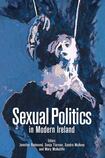
Women's experiences of life in this country have been strikingly different from men's. Sexual Politics in Modern Ireland seeks to "weave a narrative that sees gender and encounters with the political sphere, or the politicisation of gender in the public sphere, as an important paradigm for understanding how people were shaped by and sought to shape their society".
This collection of scholarly essays, edited by historians from the Women's History Association of Ireland, places itself in the tradition of Margaret MacCurtain and Donnchadh Ó Corráin, whose Women in Irish Society was published in 1978. The editors acknowledge the progress since then – and, indeed, since the 1990s, when women's history was still largely ignored by schools and universities. But they argue that some mainstream historians still regard women's history as incidental rather than crucial.
There is a great foreword by Maria Luddy, whose work on prostitution in Ireland has been so illuminating. She suggests that the formation in 1870 of the Irish branch of the Ladies National Association for the Repeal of the Contagious Diseases Act represents the first organised national campaign based on a perception of sexual oppression in this country. The law targeted prostitutes rather than those who paid them for sex.
Luddy also points out, however, that Irish nationalism politicised sexual behaviour by blaming British soldiers in Ireland for the moral and physical contagion of Irish women through their use of prostitutes. When the soldiers had gone, church and State would combine to try to impose on women standards of idealised conduct that would restore the country to purity.
Women’s places were in the home as wives and mothers. Those who did not conform were regarded as a threat and thereby stigmatised. The unmarried mother in particular was, by 1922, seen as “a symbol of unacceptable sexual activity” and a blight on the reputation of her family and country.
Blathnaid Nolan’s piece on lesbianism in the factories to which thousands of women were sent in Van Diemen’s Land up to 1853 documents the punishments for women who had, for example, become pregnant while unmarried, including hard labour and shaved heads.
The women who most alarmed the authorities were those who fought, drank, smoked and had sex with other women. Nolan describes the Flash Mob, whose members carried silk handkerchiefs, wore jewellery and led young women astray. She also describes as “amorous attentions” lesbian behaviour that sounds predatory, aggressive and abusive.
Maeve O’Riordan has a fascinating account of the explicit correspondence between an upper-class couple in the early years of the 20th century. Mabel Smyly veers between self-assertion and the longing to be “little and weak” while her man is “big and strong”, seeing in marriage the chance to become “a little bit of [his] empire” instead of remaining “a small independent province of [her] own”.
Conor Reidy examines the dismal lives of alcoholic prostitutes and efforts to “reform” them, which failed in the absence of an aftercare system.
Jennifer Redmond looks at “the politics of emigrant bodies”, noting that Catholicism so dominated the new State that bishops’ views were published without critique.
Warnings about the hazards of “agents of the white slave traffic” were issued to deter women who chose to leave a State busy enacting laws to restrict knowledge about sexuality and access to birth control; forcing women to leave paid employment on marriage; limiting their access to the higher ranks of the Civil Service; barring them from jury service; and enshrining their role in the home in the Constitution.
No use for women
John Johnston-Kehoe documents the entry of women into the police force, with
Gerald Boland stating as minister in 1944 that he had “no use for them”, while Commissioner Daniel Costigan said that the force lacked “police horses, police dogs and police women”. It was the late 1970s before women were given a full role.
Elizabeth Kiely’s interesting essay on the debate about the introduction of Relationships and Sexuality Education from 1996 to 2002 suffers from an absence of context: this was an era in which the sexual and physical abuse of children in Irish families was painfully exposed in a series of harrowing cases.
Mary Muldowney provides a coherent account of pro-choice activism in Ireland since 1983, with plenty of useful data and statistics. She quotes a banner from 1981: "The abortion mills of England grind Irish babies for blood that cries to heaven for vengeance." In 2013, by contrast, The Irish Times found from a poll that there was overwhelming support for access to abortion in a range of situations, with nearly 40 per cent supporting it "when a woman deems it to be in her best interest".
Tanya Ni Mhuirthile’s chapter on the history of “intersex in Ireland” covers a lot of ground too quickly but convincingly argues that intersex identity needs to be legitimised through gender-recognition legislation.
It is striking to consider how the ancient roots of these prejudices, which the essays expose, continue to disadvantage women in Ireland. Unmarried mothers are often still poor. Women still do not have the right to control their fertility. This book makes a good and useful contribution. Susan McKay's books include Sophia's Story and Without Fear: A History of the Dublin Rape Crisis Centre










